Click this messge to hide it.
This useful guide contains information and advice about all aspects of your delivery. Please take a few minutes to read it. Also, please print it or save it on your computer for future reference. You should also have received our Important Product Information with comprehensive advice and useful tips to help you enjoy your purchase to the full. Please contact us if you have not received it.
CONTENTS
Scroll down or click on the links below:
- IMPORTANT SAFETY INFORMATION
- YOUR GREENHOUSE DELIVERY
- INSPECTING THE GLASS
- HANDLING THE GLASS
- THE PARCEL DELIVERY
- THE LORRY
- THE PALLET TRUCK
- TAIL LIFT DELIVERY
- THE PALLET NETWORKS
- DIY INSTALLATION - SOME USEFUL TIPS
GLASS - IMPORTANT SAFETY INFORMATION
Glass is potentially a major safety hazard so if your order includes glass please read this information carefully before any glass is delivered.
- Please consider the safety of you and anybody who helps you while handling glass at your property.
- If possible you should ask your greenhouse installer to handle the glass for you. Greenhouse installers are normally experienced at handling glass.
- If you need to handle the glass yourself you should be extremely careful.
- Wear strong and thick cut resistant gloves at all times when handling glass.
- Ensure that your wrists are fully protected with long sleeves in thick and strong cut resistant fabrics.
- Wear thick and strong cut resistant footwear and trousers to protect your legs and feet.
- Carry only one piece of glass at a time.
- Always concentrate fully when handling glass from before you pick it up until after you have put it down.
Please also consider the location where the glass will be stored within your property and consider whether it is safe.
- Is it possible that you, your family or a visitor could be injured by the glass?
- Could pets or children have access to the glass?
- Is it possible to restrict access to the area, for example by locking a door or gate?
- Do any sharp edges need covering?
YOUR GREENHOUSE DELIVERY
- The picture above shows a glass crate secured to a single pallet awaiting dispatch.
- Your order includes next day delivery on any weekday of your choice, using a national pallet distribution network.
- Next day delivery is available throughout mainland England, Wales and Southern Scotland.
- Delivery is within 3-5 days in Northern Scotland.
- Options include AM delivery, PM delivery, delivery at a specific time and Saturday delivery.
- You can also request a phone call shortly before delivery, which saves people waiting around on site.
- The picture below shows a small 2' wide glass crate secured to a pallet with a 6ft 6in (2.0m) long greenhouse frame box.
- Our delivery contract is covered by an insurance policy which includes glass breakages.
- Claims are only accepted if the damage is reported in writing on the day of delivery i.e. before midnight on the day of delivery.
- Your greenhouse glass is packed in a single wooden crate, which is strapped to a single pallet.
- The glass crates are approximately 4ft wide (1200mm) and 27in high (700mm).
- The depth of the glass crates varies with the greenhouse size from 8in to 20in (200-500mm).
- Greenhouse frames up to 6ft 6in (2m) long are stood upright on the pallet and strapped to the glass crate.
- Greenhouse frames over 6ft 6in (2m) long are delivered separately on the same day by a parcel carrier.
- Any accessories you ordered are normally placed on the pallet, either in a bag or a box.
THE PALLET DELIVERY
- Single pallets are small enough to be unloaded quickly and easily with a hydraulic tail lift and a pallet truck.
- Single pallets are 4ft x 4ft (1.2m x1.2m) in area and up to 7ft 6in (2.3m) high.
- Single pallets are easier to unload than our larger pallets with fewer problems.
- We specify that the lorry must have a hydraulic tail lift at the rear of the lorry for easy off-loading
- The driver can normally lower the entire pallet to the ground in a few minutes without assistance.
- Once the pallet is on the ground it can be moved with a hydraulic pallet truck.
- The driver may be able to move the pallet some distance away from the lorry over a smooth and flat surface such as a road or drive.
- Suitable surfaces include block paving and smooth new tarmac or concrete.
- Unsuitable surfaces include shingle, gravel, ripple finish concrete, crumbling old concrete or tarmac and soil, however well compacted.
INSPECTING THE GLASS
- You or your chosen representative will need to inspect the glass on the day of delivery.
- Cut the straps which secure the crate to the pallet and ensure that the crate is stable.
- If required a second person should hold the crate steady while the other checks the glass.
- The lid is fixed to the crate with nails which are easily removed with a claw hammer or a slotted screwdriver.
- Small blocks of foam or cardboard are sometimes used to stop the glass from moving in transit. These should be removed.
- Sometimes there is a clear polythene wrapping which should be carefully folded back so it does not obstruct your view.
- With the glass loose and uncovered you should carefully check each pane of glass for damage.
- Toughened glass explodes into small pea sized pieces when it breaks, which makes it easy to notice any breakages.
- Horticultural glass breaks into large jagged shards which are especially dangerous, and breakages are more difficult to notice.
- Although safer than broken horticultural glass, the small pieces of broken toughened glass are sharp and can be dangerous
- We do not recommend bypassing or shortening the inspection procedure because claims for damage cannot be accepted later.
- After the glass has been inspected the lid can be replaced to close the crate, which affords more protection.
HANDLING THE GLASS
- At some properties the glass can be wheeled into the garage or under a carport while it is still on the pallet, in which case the glass may not need to be moved. However, this is rare.
- At most properties the glass is delivered onto the drive or pavement and it needs to be moved soon after delivery.
- The largest panes of glass are between approximately 4-5 feet tall and 2 feet wide (1.2-1.5m x 0.6m).
- Most of the panes of glass are rectangular in shape but 5 or 6 panes are triangular to suit the angle of the roof pitch.
- Use your fingertips to grip each pane of glass in turn and slide it upwards to remove it from the crate.
- Only handle one pane of glass at a time. It is slower but safer.
- The best place to store the glass is inside the wooden crate, especially if children have access to the storage area.
- The glass is rarely damaged prior to delivery. However, glass is fragile and easily damaged if it is not handled correctly.
- The crate should be stored upright and never laid flat.
- To move the glass first empty the crate, then carry the crate to your chosen storage area, then put the glass back in the crate.
- If possible store glass undercover. If the glass is stored outside it should be protected with a waterproof cover such as a tarpaulin.
- As soon as you cut the straps which secure the glass crate to the pallet the crate is potentially unstable.
- Two people are required to move the glass, one to hold the crate upright while the other carries the glass.
- At a reasonably level site little strength is required to hold the crate steady.
- After the straps have been cut the glass crate should never be left unsupported in case it falls over, which may cause breakages.
- Never attempt to move the glass crate while it contains any glass, as this may cause breakages. Only move the crate when it is empty.
THE PARCEL DELIVERY
- If your greenhouse is longer than 6'6" (2m) the box is too big for the pallet so it is delivered separately on the same day by a parcel carrier.
- The greenhouse frame box is a very large parcel which most parcel carriers refuse to carry.
- Smaller parcels up to 4ft (1.2m) long and 2ft (0.6m) wide are transported in cages, which are moved efficiently by fork lifts and require less handling as they travel quickly through the network. The cages also protect the parcels from damage.
- Unfortunately, our greenhouse frame boxes are handled manually along with other large items.
- Manual handling occasionally causes delays and damage but it is the only way such large and heavy boxes can be moved at all.
- On busy nights the networks do not always have enough space on the lorries for all of the larger parcels. If a backlog develops overnight it may not be cleared until the next day and some of our large parcels may be delayed by a day.
- It is a similar story at the central hubs where huge conveyors automatically scan and sort thousands of smaller parcels every hour.
- Unfortunately, most of our parcels are far too large for the automatic conveyors so they are sorted by hand.
- On a busy night there may not be enough staff in the hub to process all of the large parcels by hand. As a result a backlog may develop and some of our large parcels may be delayed by a day.

- The picture above shows an automatic parcel sorting line at the central hub of a major parcel distribution network.
- The conveyors on the right feed parcels from different depots into the main conveyor on the left, which travels around the entire warehouse.
- Each box is automatically scanned on the conveyors and filtered off at the correct exit.
- The conveyors are only 2ft (0.6m) wide. You can see how boxes over 4ft (1.2m) long could easily cause a pile up.
THE LORRY
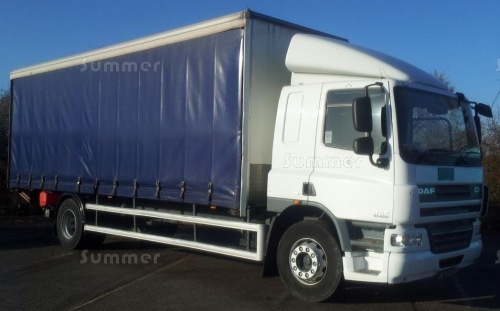
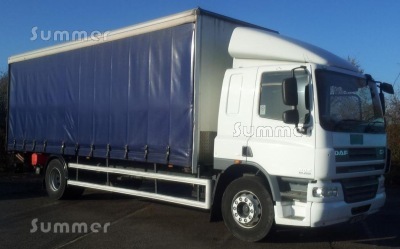
PICTURE: A typical pallet delivery lorry.
THE LORRY
- The delivery vehicle is normally a rigid lorry around 10m (33ft) long with curtain sides.
- The lorry is approximately the same length as 2 cars parked in line, but please allow 3 car lengths for manoeuvering.
- The back of the lorry is normally around 8m (27ft) long.
- Please advise if lorry access is difficult at your property.
- Reasonable access to your property and parking directly outside is assumed.
- Please advise if there are any low bridges, narrow bridges, weight limits, width limits, parking restrictions, unloading restrictions or narrow lanes at or near your property.
- Our lorry is bigger than a large bin lorry. Please advise if a large bin lorry cannot easily park outside your property.
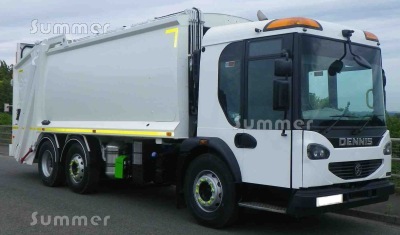
PICTURE: A large bin lorry.
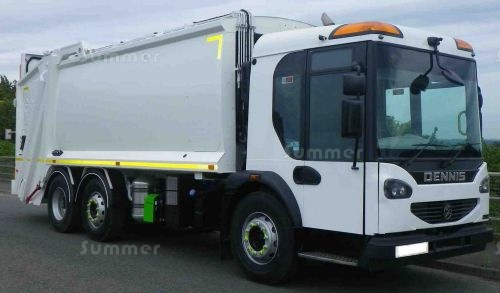
THE PALLET TRUCK
- Pallets are delivered by one driver using a hydraulic pallet truck, also called a pump truck.
- When the handle is pumped up and down the pallet is raised off the ground so it can be moved.
- Pallets are unloaded at the kerbside outside your property. It is normally possible to move the pallet onto your drive if the surface is suitable.
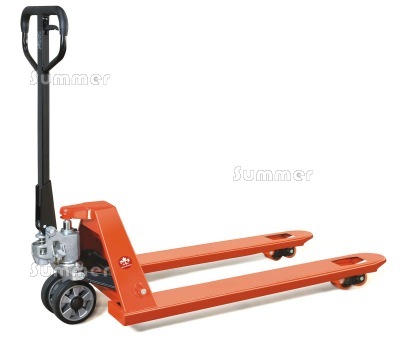
PICTURE: A pallet truck.
- A pallet truck can only move over a very smooth and flat surface. Unlike pneumatic tyres the small solid wheels cannot overcome surface irregularities. Even a tiny piece of pea shingle can stop a pallet truck.
- It is not normally possible to manoeuvre a pallet truck over steps or steep slopes.
- It is not normally possible to manoeuvre a pallet through a gate or entrance less than 4ft (1.2m) wide.
- If you have a flat drive with good access for cars and a hard smooth surface such as block paving, tarmac or concrete it is normally possible for the driver to leave your pack in a corner of the drive.
- The heavier the pallet is the harder it is to move, especially over a rough surface. Lighter pallets can be dragged over a kerb or for a short distance across gravel.
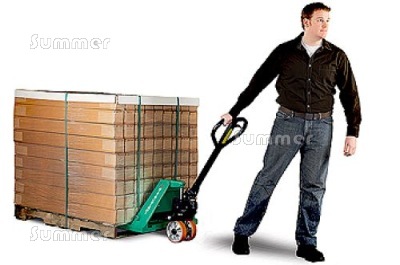
PICTURE: A pallet truck in use to move a loaded pallet.
- If you do not have a drive, if your drive slopes steeply or if the drive surface is not smooth enough for a pallet truck it may not be possible to leave the pack inside your property. In such cases we recommend a pavement delivery. This ensures that the delivery can be completed without any re-delivery charges.
- The driver will always find somewhere at or near your property to unload the pallet. Occasionally the best place is in the drive entrance blocking access for cars or on the pavement outside. Occasionally, if the road is wide enough, the best place is on the road alongside the kerb.
- Unless you live in a no loading area or an urban clearway you are entitled to receive a pavement or roadside delivery.
- You are also entitled to a reasonable time in which to move the individual components from the kerbside after a delivery.
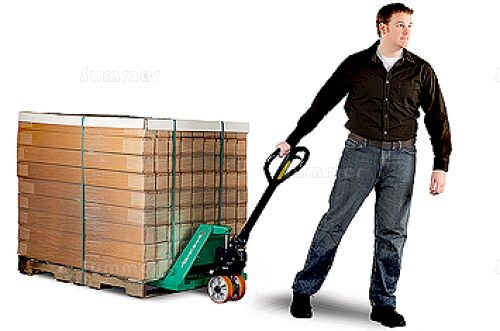
ROADSIDE DELIVERY
- If you do not have a drive, if your drive slopes steeply or if the drive surface is not smooth enough for a pallet truck it may not be possible to leave the pack inside your property. In such cases we recommend a pavement delivery. This ensures that the delivery can be completed without any re-delivery charges.
- The driver will always find somewhere at or near your property to unload the pallet. Occasionally the best place is in the drive entrance blocking access for cars or on the pavement outside. Occasionally, if the road is wide enough, the best place is on the road alongside the kerb.
- A pallet can be delivered on the road if the road is wide enough and the pallet is not an obstruction.
- If your pallet is delivered on the road the best place is directly in front of your car if it is legally parked. You should leave your car there until after the individual components have been moved off the road.
- Unless you live in a no loading area or an urban clearway you are entitled to receive a pavement or roadside delivery.
- You are also entitled to a reasonable time in which to move the individual components from the kerbside after a delivery.
- A roadside delivery should be moved before nightfall to avoid blocking the road or pavement.
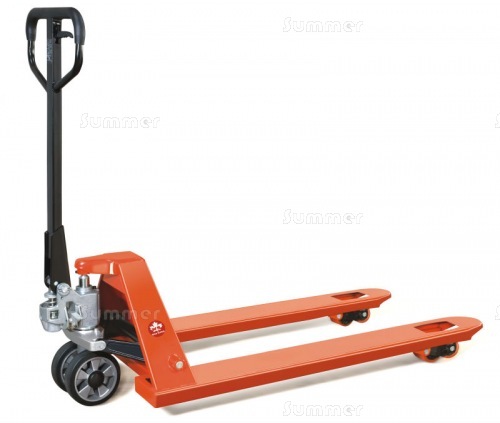
THE DRIVER
- Take advantage of the driver and their pallet truck while you can.
- Make sure the pallet is pushed as far into your property as possible. If required help the driver push it further. It could save you time later.
- Most drivers are happy to help, especially if the unloading was completed quickly and easily.
- We cannot guarantee the response of every driver but many will be happy to help you if you ask. It could save you a lot of effort.
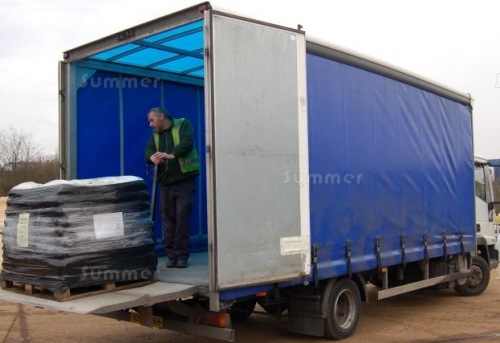
TAIL LIFT DELIVERY
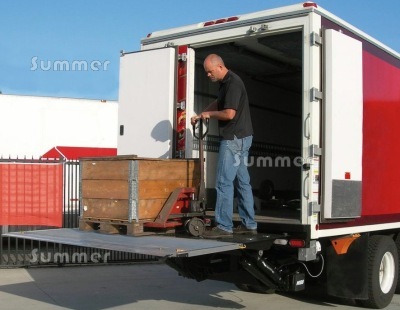
PICTURE: A pallet truck in use to move a loaded pallet, just after lowering it onto a tail lift.
- At most properties a pallet can remain on the drive for hours. However, if a pallet is delivered onto the pavement somebody may need to empty the pallet and move the individual components quickly.
- Even if the driver leaves the pack on your drive, many people move the individual components for security reasons. So whether your pack is delivered to the drive or the pavement it will often be moved on the day of delivery.
- It takes less time to empty a pallet and move the components only a few feet if required to clear the road, the pavement or a drive entrance. It may take much longer to move the components into the back garden.
- We always request a lorry with a tail lift. Occasionally if the lorry is full your pallet may be blocked from the tail lift. If so, ask the driver to return later. If this is not possible you may agree to unload the pallet by hand. If you are in a hurry this may be a better option than waiting for re-delivery. It is not much extra work if the pallet needs to be moved anyway. Unloading a pallet by hand normally takes only a few minutes.

PICTURE: A loaded pallet on a tail lift, still raised while being moved, about to be lowered to the ground.
THE PALLET NETWORKS
The only way we can deliver our pallets throughout the UK within a day or two is using national pallet networks. The service is better than the parcel networks we use for smaller deliveries, with fewer delays and much less damage. The vast majority of pallets are delivered on time and intact, but not all of them. If you are one of the unlucky ones we can only apologise and try to resolve the problem. It can be very annoying if a delivery is late or damaged. Unfortunately we cannot operate without the national pallet networks and we cannot change them. Although it does not solve anything we thought it may help you to understand a little about how they operate:

PICTURE: The central hub of a national pallet network late at night, full of pallets and trunkers being loaded and unloaded.
- National pallet networks are normally based on a bicycle wheel structure, with one central hub and lots of spokes, each leading to a local depot.
- Every day each depot collects pallets from within its own local area, which are delivered to the central hub that night.
- After each trunker lorry has been unloaded at the hub, it is loaded with pallets which need to be delivered by that depot in its local area on the following day.
- Early the next morning, the trunker lorries return to the depot with all of the pallets their depot needs to deliver that day in their local area.
- The pallets are then loaded into smaller lorries, each of which delivers and collects within a small patch of the local area.
- The local depot based near us in Norwich collects from us every day and delivers your pallet to the central hub.
- The final stage of the journey is delivery to you by your local depot.
- Every day two national networks collect pallets from our warehouses.
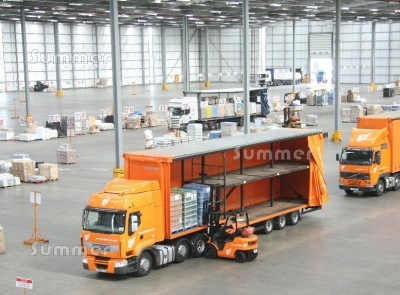
PICTURE: A network hub in the early hours, with fewer trunkers to process and most of the pallets already on their way.
- Damage is far less frequent than parcel networks because each pallet occupies its own space on the lorry.
- The pallets are picked up by forklifts and pallet trucks with no manual handling.
- With each pallet picked up and set down a minimum of eight times as it travels through the network, there is always a chance of damage or routing errors.
- Although the service for pallets is more reliable than parcels, on busy nights the networks do not always have enough space on the lorries for every pallet to every area. If a backlog develops overnight it may not be cleared until the next day and some pallets may be delayed by a day.
- Occasionally on the busiest nights the hubs are overwhelmed. This means there are more pallets than the network can deliver on the following day, so some pallets are delayed. Most delayed pallets follow on a day later than expected.
- The busiest night every week is often Thursday night, with extra pallets wanted by domestic customers on Friday for use at the weekend.
- The busiest nights of all are the night before a bank holiday weekend.
- It is not possible to forecast the spikes in demand with any degree of certainty. For example, when the sun comes out far more people buy garden products.
- The best way to avoid the rush is to order a few days earlier.

PICTURE: Articulated double decker trunkers deliver to and from the network hubs each night.
- The majority of pallet deliveries are business to business.
- Domestic pallet deliveries have grown fast in recent years, primarily due to national online retailers of bulky products, such as us.
- Most business to business deliveries are completed effortlessly within a few minutes, because most businesses have a forklift and easy access for lorries.
- The drivers get to know each business on their patch and often collect or deliver every day from the same premises and the same industrial estates.
- Occasionally, business to business deliveries are awkward if the business has no forklift or if lorry access is difficult. To deal with this, many of the pallet lorries feature a hydraulic tail lift, which allows the driver to unload the pallet quickly and easily without assistance using a manual pallet truck. It is this aspect of the pallet service which we utilize.
- Domestic deliveries are more challenging due to restricted lorry access at some addresses, properties with no drive, drive surfaces which are unsuitable for pallet trucks and customers who are away at work on weekdays.
- Our logistics team are expert at overcoming any obstacles.
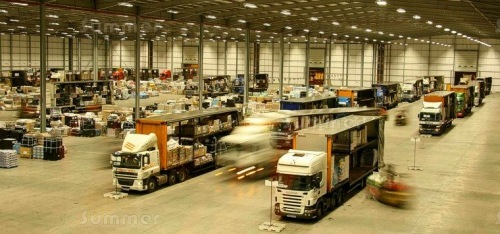
DIY INSTALLATION - SOME USEFUL TIPS
- If you are installing your first greenhouse be prepared for it to take a long time.
- Do not attempt to glaze a greenhouse in windy weather.
- Beware at all times while handling glass which is dangerous.
- Beware at all times while handling metal components with sharp edges.
- Wear gloves throughout the assembly.
- Wear goggles or glasses whenever you handle glass or spring clips.
- Keep pets and children away during installation.
- Read the instructions fully before you start.
- It can save valuable time later if you know the next few steps and the order in which the assembly should be carried out.
- Check that all components including the glazing are present before starting the installation.
- Keep all fixings and small components in a container so you cannot lose them.
- Do not force the components into position.
- Do not cut or drill any components without first consulting us.
- Do not tighten the fixings until the end. The bolts should be finger tight until the assembly is complete. This ensures flexbility which you will need throughout the installation, especially at the end.
- Assume that the components have been precisely and correctly made. Mistakes are rare. If the components do not fit together easily it is probably because you are holding one of the components inside out or upside down.
- Assume that all of the components have been delivered. Mistakes are rare. If you cannot find a component look again. Perhaps the missing component is much smaller than you expect? Perhaps it is packed with a larger component and you missed it? Perhaps the missing component has already been fitted to another component so it is not separate.
- Do not always trust the instructions in every detail because occasional typographical and numerical errors can occur.
- Do not throw away any packaging until the installation is complete. If you are missing any components check the packaging thoroughly.
- Be systematic and methodical. Try every possible way of assembling the components in turn until you find the correct combination. There are not many different combinations.







